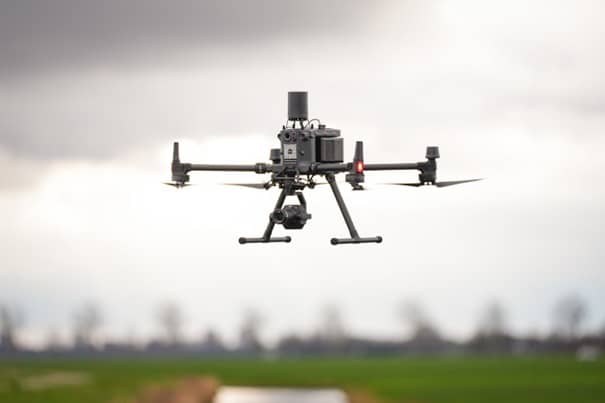Transforming industries with automation and innovation
As we look to the future, the integration of drone inspection systems and advanced data processing tools is set to shape business operations even further. Sound interesting? Let us show you just what’s possible.
Automation and human expertise
One of the most promising advancements in this field is the “drone-in-a-box” solution. These systems, housed in weather-resistant enclosures, are designed to autonomously launch, execute flight paths, carry out data capture, and return for charging and data upload. In the coming years, we can expect these solutions to become more prevalent, particularly for routine tasks such as leak detection, safety inspections, and environmental monitoring.

Drones enable 24/7 asset monitoring with minimal on-site presence
On top of that, the ability to deploy drones on-demand and manage them remotely offers businesses the possibility of continuous, 24/7 coverage of their assets, reducing the need for on-site hours by people and minimizing downtime.
However, the path to full automation is not without its challenges. We’re asked a lot about AI’s application in this space and the truth is that right now there aren’t big enough datasets to train a model on in this specific use case. Beyond that, the practical challenges of obtaining the necessary permits for drone operations, particularly in sensitive or regulated areas, remain a significant challenge, and for good reason. Safety should always be the top priority on tank storage sites.
Automation still needs human expertise in critical moments
While drone-in-a-box systems promise automation, there is still a need for human oversight, particularly when it comes to interpreting complex data or making on-the-spot decisions during unexpected events. Most notably weather. For instance, in specialized tasks like Optical Gas Imaging (OGI) for emissions detection, the technology is still too expensive and intricate to be fully automated. These missions require skilled operators to run flights involving the high-end cameras required to do the job
The best view
While we started life purely innovating in the application of drone technology, we quickly saw the potential of integrating that into modern data management, and leading organizations around the world are now priming themselves to be at the forefront of this transformation. By integrating drone systems with advanced data platforms, we’re helping our clients unlock the full potential of digital inspection. For example, our SiteXplorer platform allows companies to centralize and visualize operational data in a way that enhances decision-making and collaboration across departments. By using drones to capture high-resolution 360-degree images, we enable clients to create a detailed historical record of their sites, which can be accessed and analyzed from anywhere in the world by any team that needs to see it.
Remote monitoring boosts safety and site readiness
This approach not only improves operational efficiency but also supports better planning and emergency response. The ability to monitor sites continuously, even in adverse weather conditions, means that safety standards are maintained without the need for constant on-site presence, a big win-win. This is particularly valuable in industries like tank storage, where safety and environmental compliance are so critical.
Driving the future of drone technology
But visualizing data doesn’t have to stop there. When it comes to building projects on-site or the creation of new tanks, being able to assess site progress is a big deal for project leads and contractors alike. We’re now exploring ways to help that process with the creation of hyper-lapses, time-lapse videos that condense weeks or months of work into a few minutes, providing a clear view of the construction progress on long-term projects. After all, pictures and videos do a much better job of demonstrating progress than a written report. The future of drone technology is very exciting, with automation, data integration, and remote monitoring accelerating at an incredible rate, all with the support of human experts. We’re not just adapting to these changes. We’re driving them, providing our customers with the tools and skills needed to stay ahead in competitive markets.
It’s amazing to think that drone technology has come so far so quickly, with the ways it can be applied being so diverse and impactful. We just can’t wait to see what happens in the next five years!